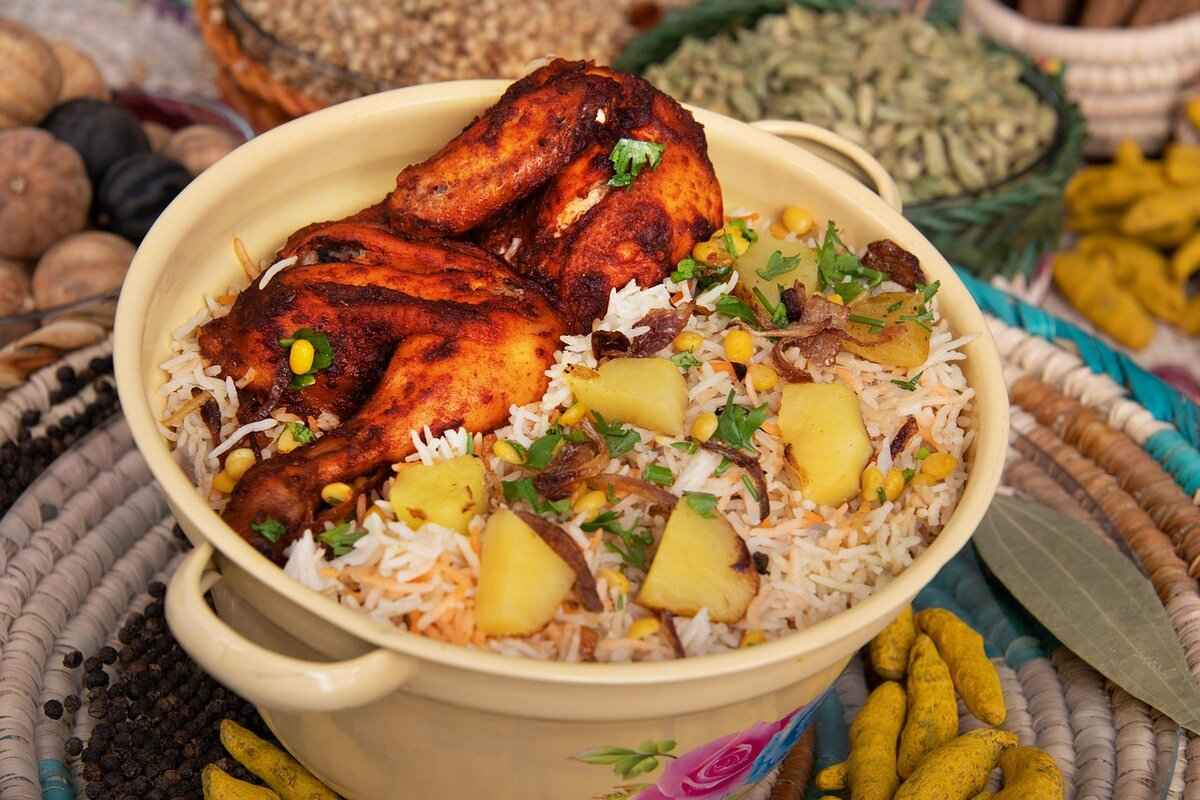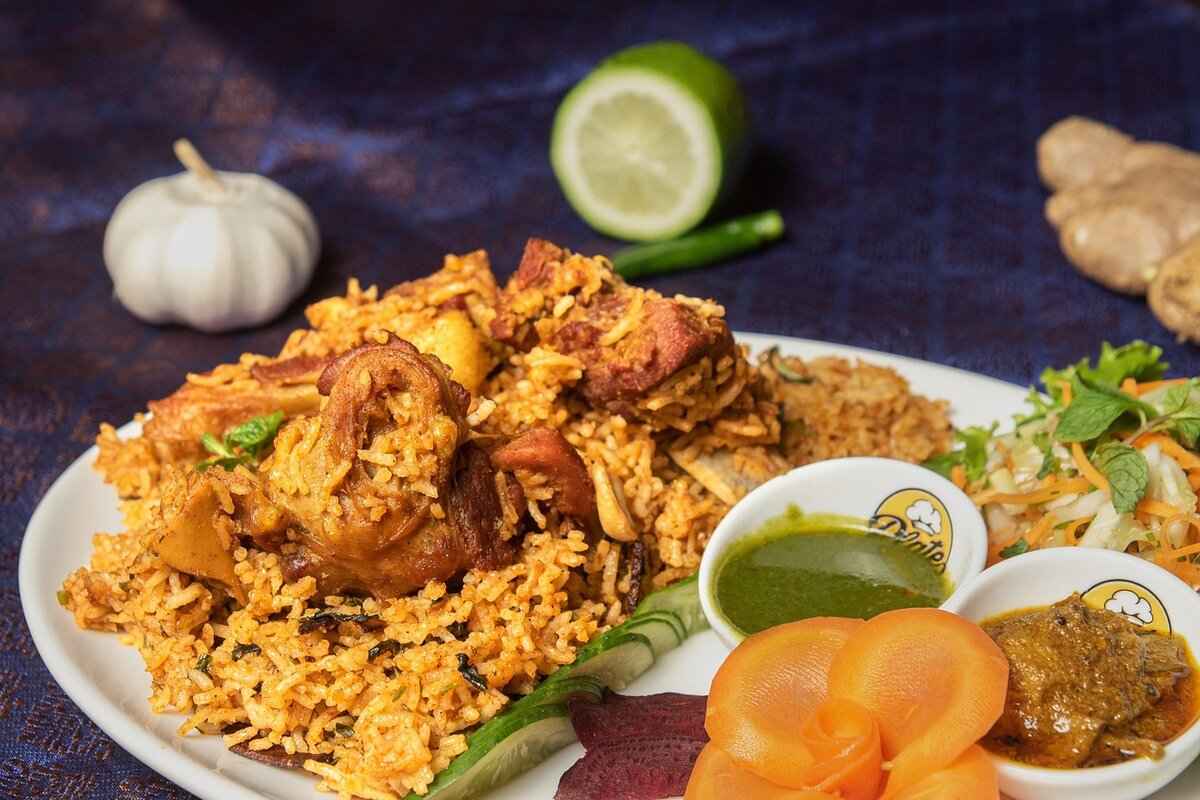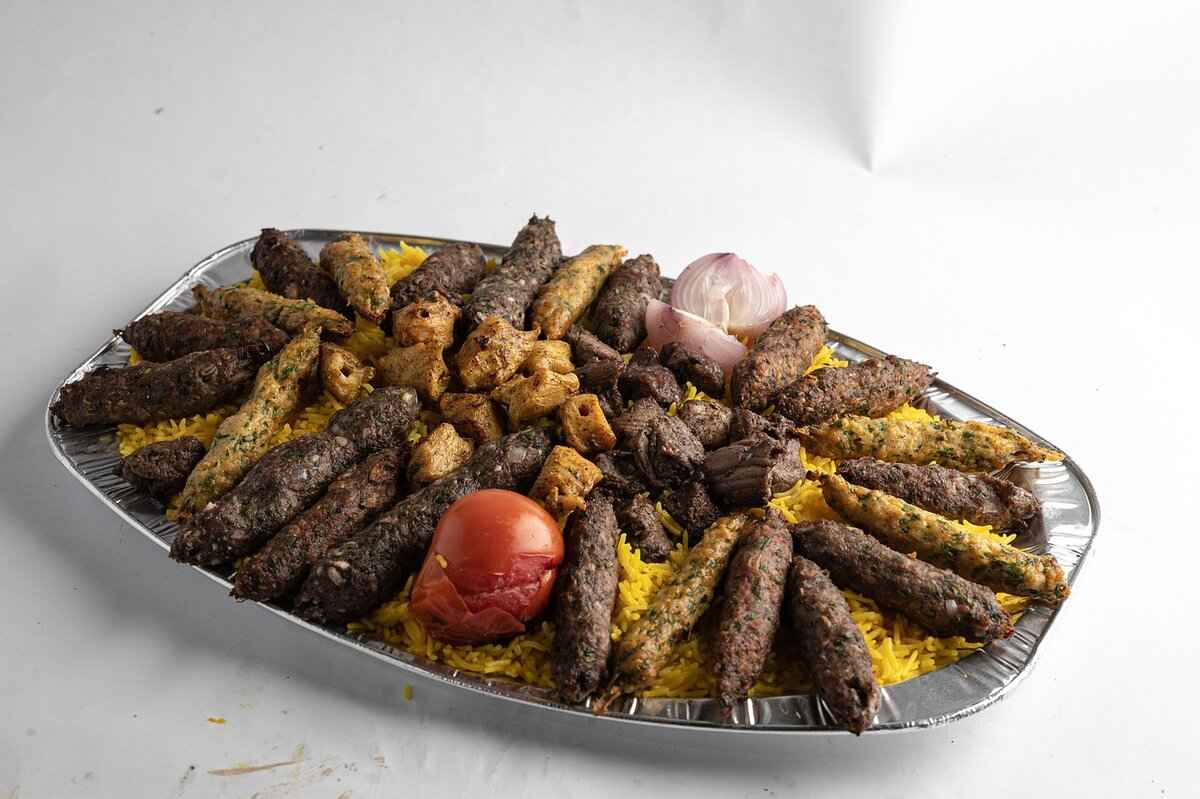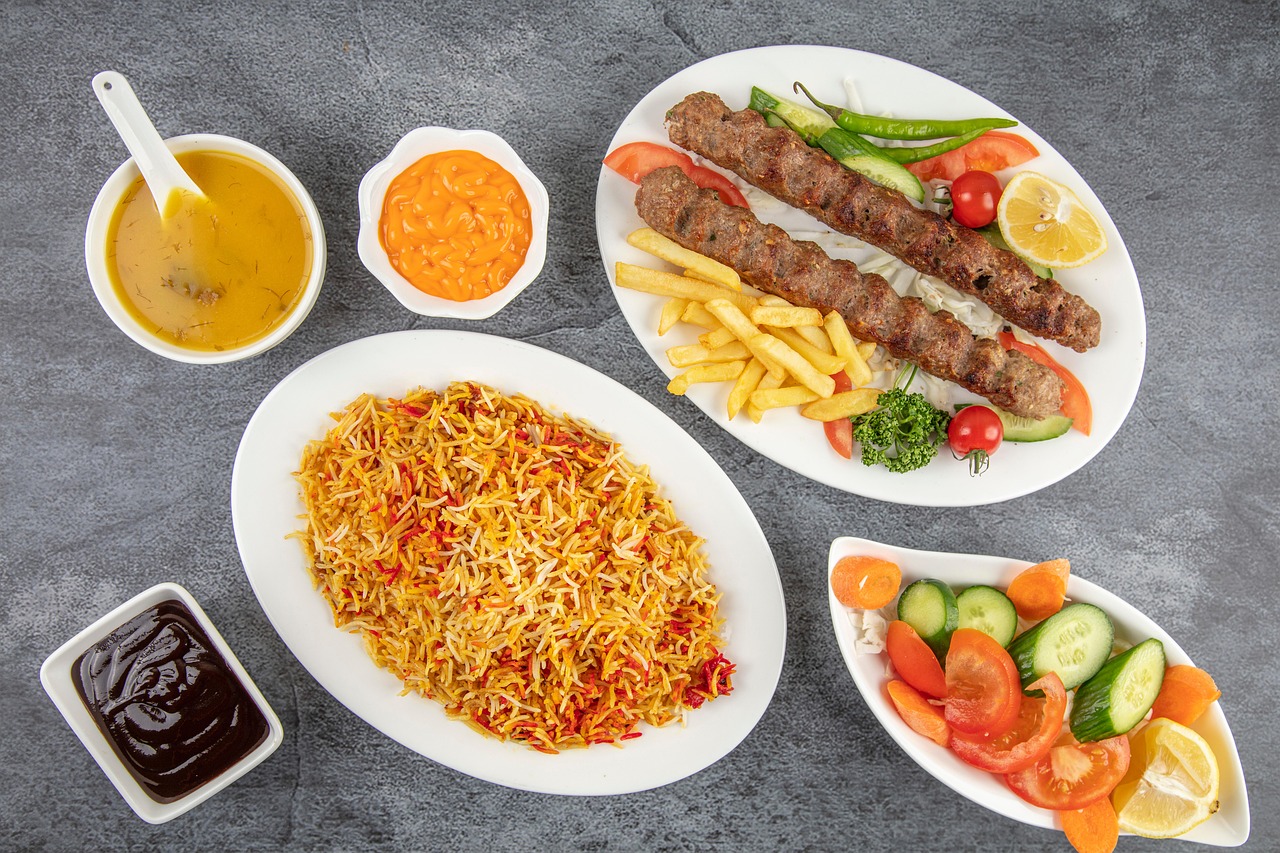Biryani is more than just a dish; it is a culinary experience that encapsulates the rich tapestry of flavors, traditions, and histories. This beloved rice dish has transcended borders, captivating food enthusiasts around the globe with its unique blend of spices and ingredients. Each region has its own interpretation, ensuring that biryani remains a vibrant part of culinary culture.
Biryani is a mixed rice dish originating from South Asia, characterized by its aromatic spices and the layering of rice with meat or vegetables. Typically, it consists of long-grain rice, marinated meat, and a medley of spices, all cooked together to create a harmonious blend of flavors. The preparation methods can vary, but the essence of biryani lies in its ability to deliver a satisfying meal that is both flavorful and nourishing.
The evolution of biryani is a fascinating journey through time, influenced by various cultures and culinary practices. Its origins can be traced back to the Persian influences during the Mughal Empire, where it was introduced to Indian cuisine and adapted to local tastes and ingredients.
Biryani’s roots can be traced back to the Persian word ‘birian,’ which means ‘fried before cooking.’ This method of preparation was introduced to India by the Mughals, who brought with them a rich culinary heritage. The Mughal Empire played a crucial role in popularizing biryani, blending Persian cooking techniques with Indian spices and local ingredients.
As biryani spread across different regions, local flavors and cooking methods led to a myriad of adaptations. From the Hyderabadi biryani, known for its rich aroma and spicy flavor, to the Kolkata biryani, which incorporates potatoes and boiled eggs, each variant tells a story of its own.
Different regions boast their unique biryani styles. Some of the most popular variants include:
- Hyderabadi Biryani: A fragrant blend of basmati rice and marinated meat, cooked in a sealed pot.
- Kolkata Biryani: A lighter version that includes potatoes and is flavored with saffron.
- Lucknowi (Awadhi) Biryani: Known for its delicate flavors and slow-cooking method.
- Sindhi Biryani: A spicy variant that includes tangy yogurt and potatoes.
Understanding the essential ingredients in biryani is crucial for appreciating its flavors. The primary components include:
- Rice: Basmati rice is the preferred choice for its long grains and fragrant aroma.
- Meat: Common choices include chicken, mutton, and beef, but vegetarian options are also popular.
- Spices: A mix of spices such as cardamom, cloves, and bay leaves are essential for flavor.
Making biryani at home can be a rewarding experience. Here’s a step-by-step guide:
1. Marinate the meat with yogurt and spices for a few hours.2. Parboil the rice with some whole spices.3. Layer the marinated meat and rice in a pot.4. Cook on low heat, allowing the flavors to meld together.5. Serve hot with raita or salad.
Biryani holds significant cultural importance in various regions. It is often a centerpiece in celebrations and festivals, symbolizing unity and celebration. In many cultures, biryani is synonymous with feasts and gatherings, making it a dish that brings people together.
During weddings, festivals, and family gatherings, biryani often takes center stage, showcasing its role as a dish of abundance and joy.
Some regions even host festivals dedicated to biryani, where local chefs showcase their unique recipes, celebrating the dish’s versatility and cultural significance.
Pairing biryani with the right side dishes can enhance the dining experience. Popular accompaniments include:
- Raita: A yogurt-based side that cools the palate.
- Salad: Fresh vegetables to balance the richness of the biryani.
- Pickles: For an added punch of flavor.

What Is Biryani? Understanding the Basics
Biryani is a celebrated mixed rice dish that has its origins deeply rooted in South Asia. Renowned for its aromatic spices and the intricate layering of rice and meat, biryani has become a culinary masterpiece that transcends borders. This dish is not only a feast for the senses but also a reflection of the rich cultural tapestry of the regions it hails from.
At its core, biryani is a dish that combines rice, meat (or vegetables), and a blend of spices, creating a symphony of flavors. The preparation of biryani typically involves layering partially cooked rice with marinated meat, which is then cooked together to allow the flavors to meld beautifully. The result is a dish that is both aromatic and flavorful, with each bite offering a delightful experience.
- Rice: The type of rice used is crucial to the dish’s success. Long-grain varieties like Basmati are preferred for their ability to remain fluffy and separate.
- Meat or Vegetables: Common choices include chicken, mutton, beef, or even seafood, while vegetarian options often feature paneer or a medley of vegetables.
- Spices: A blend of spices, including saffron, cardamom, and cloves, is essential for achieving the signature flavor profile.
- Herbs: Fresh herbs like mint and coriander are often used to garnish the dish, adding a burst of freshness.
The preparation of biryani can vary significantly by region, but two primary methods are widely recognized:
- Kacchi Biryani: In this method, raw marinated meat is layered with rice and cooked together, allowing the meat to infuse the rice with its juices.
- Pukki Biryani: This technique involves cooking the meat and rice separately before layering them together for the final cooking phase.
Biryani is not a one-size-fits-all dish; it has numerous regional variations that reflect local tastes and ingredients. For instance:
- Hyderabadi Biryani: Known for its rich flavors and the use of saffron, this variant is famous for its spicy marinated meat.
- Kolkata Biryani: This version features potatoes and boiled eggs, showcasing a unique twist on the traditional recipe.
- Lucknowi Biryani: Characterized by its subtle flavors and aromatic spices, this biryani is often cooked using the dum method, which involves sealing the pot to trap steam.
In conclusion, biryani is a dish that not only satisfies the palate but also tells a story of cultural exchange and culinary evolution. Its fundamental components and diverse preparation methods contribute to its status as one of the most beloved dishes across the globe.

How Did Biryani Evolve Over Time?
Biryani, a dish renowned for its rich flavors and fragrant spices, has a captivating history that reflects the cultural amalgamation of various regions. The evolution of biryani is not just a culinary journey; it is a testament to the historical interactions among different civilizations. In this section, we will delve into how biryani transformed from its origins to the beloved dish we cherish today.
The historical roots of biryani can be traced back to the Persian word ‘birian’, which means ‘fried before cooking’. This indicates that the dish was initially prepared using fried rice and meat. Its introduction to the Indian subcontinent is often attributed to the Mughal Empire in the 16th century. The Mughals, with their sophisticated culinary techniques, blended Persian cooking styles with local Indian flavors, giving birth to what we now recognize as biryani.
During the Mughal era, biryani became a royal dish, served in palaces and enjoyed by the elite. The Mughal kitchens, known for their opulence, adopted various cooking methods, such as dum cooking, where the dish is slow-cooked in a sealed pot. This technique allowed the flavors to meld beautifully, resulting in a rich and aromatic dish. The Mughals introduced saffron and dried fruits, enhancing the dish’s luxurious appeal.
As biryani spread across the Indian subcontinent and beyond, it underwent numerous transformations, adapting to local ingredients and tastes. Each region developed its unique style:
- Hyderabadi Biryani: Known for its rich flavors and use of marinated meat, this variant is famous for its spicy and tangy taste.
- Kolkata Biryani: Influenced by Awadhi cuisine, it is characterized by the addition of potatoes and boiled eggs, creating a unique texture.
- Lucknowi Biryani: This style is lighter on spices and focuses on the aroma of the rice, often prepared with tender meat.
- Malabar Biryani: Known for its use of short-grain rice and coconut, this variant reflects the coastal flavors of South India.
With the migration of people and the spread of the Indian diaspora, biryani found its way to various countries, each adding its twist. In the Middle East, for example, you will find Kabsa, a rice dish that shares similarities with biryani but is often spiced differently. In Southeast Asia, Nasi Goreng showcases the influence of biryani in its fried rice preparations.
Biryani is more than just a dish; it is a symbol of celebration and festivity. In many cultures, biryani is the centerpiece of weddings, festivals, and family gatherings. Its preparation often involves communal cooking, bringing families and friends together. The dish has become a part of cultural identity, celebrated in regional festivals that honor its diverse variations.
In conclusion, the evolution of biryani is a rich tapestry woven through history, culture, and culinary artistry. From its royal beginnings in the Mughal kitchens to its global adaptations, biryani continues to delight palates and foster connections among people, making it a truly timeless dish.
Historical Roots of Biryani
Biryani is not just a dish; it is a culinary experience that encapsulates centuries of history, culture, and tradition. Its historical roots are deeply embedded in the Persian influences that permeated Indian cuisine during the time of the Mughal Empire. Understanding the origins of biryani provides insight into its evolution and the rich tapestry of flavors that characterize this beloved dish.
The journey of biryani began in Persia, where rice was often cooked with spices and meats, creating a flavorful dish. When the Mughals invaded India in the 16th century, they brought with them their culinary traditions, including the art of making biryani. The royal kitchens of the Mughal emperors became the birthplace of the dish as we know it today, blending Persian techniques with local Indian spices and ingredients.
The Mughal Empire played a pivotal role in popularizing biryani across the Indian subcontinent. The emperors, known for their lavish feasts, favored biryani as a centerpiece of their banquets. The dish was often prepared with marinated meats and layered with fragrant basmati rice, creating a culinary masterpiece that was both visually appealing and delicious.
Biryani is characterized by its use of high-quality ingredients. The key components include:
- Basmati Rice: Renowned for its long grains and aromatic flavor, basmati rice is essential for authentic biryani.
- Meat: Traditionally made with chicken, lamb, or beef, biryani can also be prepared vegetarian with paneer or mixed vegetables.
- Spices: A blend of spices such as cumin, cardamom, and cinnamon is crucial for achieving the dish’s signature flavor.
As biryani spread across India, it absorbed regional influences, leading to a plethora of variations. Each region adapted the dish to suit local tastes and available ingredients. For instance:
- Hyderabadi Biryani: Known for its spicy flavor and use of saffron, this variant is a favorite in South India.
- Kolkata Biryani: This version incorporates potatoes and boiled eggs, offering a unique twist to the traditional recipe.
- Lucknowi (Awadhi) Biryani: Characterized by its subtle spices and slow-cooking technique, this variant emphasizes the use of yakhni (broth) for added flavor.
Biryani is more than just a meal; it is a symbol of celebration in Indian culture. It is often served at weddings, festivals, and family gatherings, signifying unity and festivity. The dish transcends regional boundaries, bringing people together to share in its rich flavors and history.
In conclusion, the historical roots of biryani illustrate the dish’s evolution from Persian influences to a staple in Indian cuisine. Its journey reflects the cultural amalgamation that defines the Indian subcontinent, showcasing how food can tell stories of migration, adaptation, and celebration.
The Mughal Influence on Biryani
The Mughal Empire, which reigned over much of the Indian subcontinent from the early 16th to the 19th century, is renowned for its profound impact on the region’s culinary landscape. Among the many dishes that emerged during this era, biryani stands out as a remarkable fusion of flavors and techniques. This section delves into how the Mughal kitchens not only popularized biryani but also refined its preparation, making it a staple of royal feasts.
The Mughal emperors, with their passion for lavish banquets, brought together Persian culinary traditions and Indian spices to create a unique dish that would become synonymous with royalty. The introduction of layering techniques in cooking, where marinated meat is layered with partially cooked rice, allowed for the infusion of flavors, resulting in a dish that was both aromatic and visually stunning.
The royal kitchens, known as kitchen khana, were bustling centers of culinary innovation. Here, skilled chefs known as khansamas experimented with various ingredients and techniques. The use of saffron, dried fruits, and a variety of spices like cardamom and cloves was perfected in these kitchens, contributing to the distinctive taste of Mughal biryani.
- Rice: The choice of rice was crucial. The Mughals favored long-grain basmati rice for its aroma and texture.
- Meat: Traditionally, mutton or chicken was used, marinated in yogurt and spices to enhance flavor.
- Spices: A blend of spices, including cumin, coriander, and nutmeg, created the rich flavor profile.
- Garnishes: Fried onions, fresh herbs, and nuts were often used to finish the dish, adding texture and flavor.
Biryani was not just a dish; it was a symbol of prestige and celebration. Served during royal banquets and significant cultural events, it represented the wealth and sophistication of Mughal society. The meticulous preparation and presentation of biryani reflected the empire’s values of artistry and hospitality.
Even today, the influence of Mughal biryani can be seen across various regions of India and beyond. Each area has adapted the dish to incorporate local flavors and ingredients, resulting in a plethora of biryani styles, from Hyderabadi to Kolkata. The essence of Mughal biryani, however, remains intact, celebrated for its rich history and culinary excellence.
In conclusion, the Mughal Empire’s contribution to the world of biryani is undeniable. Through their royal kitchens, they transformed a simple rice dish into a culinary masterpiece that continues to delight palates worldwide. The blend of Persian and Indian culinary traditions not only created a beloved dish but also left a lasting legacy that is cherished in modern cuisine.
Regional Adaptations Over Time
Biryani, a dish steeped in history and flavor, has undergone numerous transformations as it traveled across various regions. Each locale has embraced biryani, infusing it with local ingredients, spices, and cooking techniques, resulting in a rich tapestry of flavors and styles. In this section, we delve into the regional adaptations of biryani, showcasing how different cultures have made this beloved dish their own.
The journey of biryani is a fascinating tale of cultural exchange and culinary innovation. As biryani migrated from its roots in Persia to the Indian subcontinent and beyond, it encountered a myriad of local influences. Here, we explore how various regions have tailored biryani to reflect their unique culinary identities.
One of the most famous variants is the Hyderabadi biryani, which is renowned for its rich flavors and aromatic spices. This version often features marinated meat layered with partially cooked rice, then finished together in a sealed pot, a technique known as dum cooking. The use of saffron and fried onions adds to its luxurious appeal, making it a staple at weddings and celebrations.
- Kolkata Biryani: This variant is distinguished by its use of potatoes and boiled eggs, a remnant of the dish’s royal past. The meat is often cooked with yogurt and spices, resulting in a subtly flavored biryani that contrasts with its spicier counterparts.
- Awadhi Biryani: Originating from Lucknow, Awadhi biryani is known for its slow-cooked meat and rice, which are prepared separately and then layered together. The emphasis on fragrant spices and the technique of kacchi biryani (raw meat layered with rice) sets it apart.
The Chettinad biryani hails from Tamil Nadu and is characterized by its fiery spices and robust flavors. This version often incorporates a variety of meats and is served with a spicy salna (curry) on the side, making it a favorite among spice lovers.
In contrast, Sindhi biryani is known for its tangy flavor profile, often enhanced by the addition of yogurt and tamarind. This variant tends to be less spicy but is rich in flavor, showcasing the culinary traditions of the Sindhi community.
As biryani has traveled beyond South Asia, it has inspired unique adaptations worldwide. For instance, in Middle Eastern countries, biryani often incorporates local spices and nuts, while in East Africa, it may be served with kachumbari (a fresh tomato and onion salad) to balance the rich flavors.
Biryani is not just a dish; it is a symbol of hospitality and celebration across cultures. In many regions, biryani is served during festivals, weddings, and family gatherings, showcasing its significance in bringing people together. Each region’s unique take on biryani reflects its culinary heritage, making it a beloved dish that transcends borders.
In conclusion, the regional adaptations of biryani highlight the dish’s versatility and cultural importance. From the spicy depths of Chettinad to the royal flavors of Awadhi, each variation tells a story of tradition, innovation, and community. As biryani continues to evolve, it remains a testament to the rich tapestry of culinary practices across the globe.
Popular Variants of Biryani
Biryani, a dish that has transcended borders, is celebrated for its diverse regional adaptations. Each variant showcases a unique blend of spices, cooking techniques, and local ingredients, making biryani a true culinary masterpiece. In this section, we will explore some of the most popular biryani variants, highlighting their distinctive characteristics and flavors.
- Hyderabadi Biryani: Known for its rich flavors and fragrant aroma, this variant hails from Hyderabad, India. It typically features marinated meat layered with partially cooked basmati rice, then slow-cooked to perfection. The use of saffron and fried onions adds a luxurious touch.
- Kolkata Biryani: This variant is unique due to the inclusion of potatoes and boiled eggs alongside the meat. The Kolkata biryani is known for its subtle spices and a hint of sweetness, often attributed to the use of kewra water.
- Lucknowi (Awadhi) Biryani: Originating from Lucknow, this biryani is characterized by its dum cooking technique, where the ingredients are cooked in a sealed pot. It is lighter on spices compared to its Hyderabadi counterpart and often features tender meat and aromatic rice.
- Thalassery Biryani: Hailing from the Malabar region of Kerala, Thalassery biryani uses a short-grain rice called ‘kaima’ or ‘jeerakasala.’ It is known for its unique blend of spices, including cardamom and cloves, and often includes fried cashews and raisins for added richness.
- Sindhi Biryani: This variant is known for its spicy kick, often incorporating tangy yogurt and green chilies. Sindhi biryani is typically made with beef or mutton and is accompanied by a spicy raita to balance the flavors.
The ingredients used in biryani vary significantly from region to region, reflecting local agricultural practices and cultural preferences. For instance, the use of fresh seafood in coastal areas leads to the creation of exquisite seafood biryanis, while meat-based biryanis dominate in regions with a rich pastoral tradition.
Moreover, the choice of rice is crucial in determining the texture and flavor of biryani. While basmati rice is favored in North India for its long grains and aroma, South Indian biryanis might utilize shorter grain varieties that absorb flavors differently.
Each biryani variant tells a story of its region, shaped by history, culture, and local ingredients. The cooking methods also contribute to their uniqueness; for example, the dum method used in Lucknowi biryani allows for the flavors to meld beautifully, while the layering technique in Hyderabadi biryani creates a distinct texture.
The cultural significance of biryani cannot be overstated. In many regions, biryani is not just a dish but a symbol of celebration, often served during weddings, festivals, and family gatherings. Each variant carries with it a piece of history, making it more than just a meal but a shared experience.
In conclusion, the diversity of biryani variants across regions showcases the rich tapestry of culinary traditions that contribute to this beloved dish. From the spicy Sindhi biryani to the aromatic Hyderabadi version, each style offers a unique taste of its cultural heritage, inviting food lovers to explore and savor the flavors of biryani.

What Are the Key Ingredients in Biryani?
Biryani is much more than just a rice dish; it is a culinary masterpiece that embodies a rich tapestry of flavors, textures, and aromas. To truly appreciate this dish, it is essential to understand the key ingredients that contribute to its unique profile. This section walks you through the primary components that make biryani an unforgettable experience.
The magic of biryani lies in its carefully selected ingredients, which combine to create a symphony of flavors. Below are the fundamental elements that contribute to the deliciousness of biryani:
- Rice: The backbone of biryani, rice varieties such as Basmati or Seeraga Samba are preferred for their long grains and aromatic qualities. The choice of rice greatly influences the texture and overall taste of the dish.
- Meat: Biryani is traditionally made with various types of meat, including chicken, lamb, beef, or goat. Each type brings its own unique flavor profile. For vegetarian options, ingredients like paneer or mixed vegetables can be used to create equally delicious alternatives.
- Spices: A blend of spices is crucial for biryani’s signature flavor. Common spices include cumin, cardamom, cloves, cinnamon, and bay leaves. The right combination and proportions can elevate the dish from ordinary to extraordinary.
- Herbs: Fresh herbs like cilantro and mint not only add freshness but also enhance the aromatic experience of biryani. They are often layered between the rice and meat for maximum flavor infusion.
- Yogurt: This ingredient is often used as a marinade for the meat. Yogurt tenderizes the meat while adding a creamy texture and tangy flavor, balancing the spices beautifully.
- Onions: Caramelized onions are a common addition, providing sweetness and depth. They can be fried until golden brown and used as a garnish, adding both flavor and visual appeal to the dish.
- Ghee or Oil: Cooking biryani in ghee (clarified butter) adds richness and enhances the overall flavor. Alternatively, vegetable oil can be used for a lighter version.
The interplay of these ingredients is what makes biryani so special. When cooked together, the spices release their essential oils, infusing the rice and meat with deep flavors. The layering technique—where partially cooked rice is layered with marinated meat and then cooked together—allows for a perfect melding of flavors.
Moreover, the moisture from the meat and yogurt helps steam the rice, resulting in fluffy grains that are not sticky. Each bite offers a burst of flavor, showcasing the aromatic spices and tender meat, complemented by the freshness of herbs.
In summary, understanding the key ingredients in biryani is vital for appreciating its complex flavors and textures. Each component plays a significant role in creating this beloved dish, making it a cherished part of culinary traditions across the globe.
Rice Types Used in Biryani
Biryani, a beloved dish across many cultures, is not just about the spices and meats; the choice of rice plays a crucial role in defining its texture and flavor. In this section, we will explore the most common rice varieties used in making biryani, highlighting their unique characteristics and how they contribute to the overall experience of this exquisite dish.
The type of rice used in biryani is essential for achieving the desired fluffiness and aroma. Different rice varieties absorb water differently and release starch, which can significantly alter the final outcome of the dish. Here are the most popular rice types:
- Basmati Rice: Known for its long grains and aromatic fragrance, Basmati rice is often the top choice for biryani. Its ability to remain separate and fluffy after cooking makes it ideal for layering with meat and spices.
- Seeraga Samba Rice: This variety is smaller in size and is particularly popular in South Indian biryanis. It has a unique flavor and aroma, often preferred for its sticky texture that holds the spices well.
- Jasmine Rice: While not traditional, Jasmine rice is used in some regions for its fragrant quality. It tends to be slightly stickier than Basmati, making it suitable for those who enjoy a softer texture.
- Brown Rice: For a healthier alternative, brown rice can be used in biryani. It has a nuttier flavor and chewy texture, but requires longer cooking times and more water.
Each rice variety brings its own unique qualities to biryani:
| Rice Type | Texture | Flavor Profile | Cooking Time |
|---|---|---|---|
| Basmati Rice | Fluffy and separate | Aromatic and nutty | 15-20 minutes |
| Seeraga Samba Rice | Sticky | Distinct and earthy | 20-25 minutes |
| Jasmine Rice | Soft and slightly sticky | Floral and sweet | 15-20 minutes |
| Brown Rice | Chewy | Nutty | 40-50 minutes |
When selecting rice for biryani, consider the following factors:
- Texture Preference: Decide if you prefer fluffy grains or a stickier consistency.
- Aroma: Choose a variety that complements the spices used in your biryani.
- Cooking Time: Ensure that the rice you choose fits within your cooking schedule.
In summary, the choice of rice is pivotal in crafting the perfect biryani. Each variety offers distinct qualities that can enhance the dish’s flavor and texture, making it essential to select the right type based on personal preference and regional traditions.
Meat and Vegetarian Options
Biryani, a beloved dish known for its rich flavors and aromatic spices, offers a versatile canvas for culinary creativity. It can be crafted using a variety of proteins or can be made entirely vegetarian, catering to diverse palates and dietary preferences. In this section, we will explore the different meat choices and plant-based alternatives available for biryani enthusiasts.
When it comes to meat options, biryani is highly adaptable. Here are some popular choices:
- Chicken Biryani: A favorite among many, chicken biryani is made using marinated chicken pieces cooked with fragrant basmati rice. The spices used can vary, but they often include cardamom, cloves, and saffron.
- Lamb Biryani: Known for its rich flavor, lamb biryani features tender pieces of lamb that are slow-cooked to perfection. The meat absorbs the spices, resulting in a hearty dish.
- Beef Biryani: A less common but equally delicious option, beef biryani is popular in certain regions. The beef is marinated and cooked with rice, offering a robust flavor.
- Fish and Seafood Biryani: In coastal areas, biryani made with fish or prawns is quite popular. The seafood adds a unique twist to the traditional recipe.
For those who prefer plant-based options, biryani can be just as delightful. Here are some vegetarian alternatives:
- Vegetable Biryani: A colorful mix of seasonal vegetables such as carrots, peas, and bell peppers are cooked with basmati rice and spices, creating a wholesome and nutritious meal.
- Paneer Biryani: Paneer, or Indian cottage cheese, is a great source of protein for vegetarians. It can be added to biryani for a creamy texture and rich flavor.
- Mushroom Biryani: Mushrooms add an earthy flavor and meaty texture to biryani. This variant is particularly popular among those who enjoy the umami taste.
- Tofu Biryani: For a vegan option, tofu can be marinated and used in place of meat. It absorbs spices well and provides a satisfying protein source.
Each protein or plant-based alternative brings its own unique flavor and texture to biryani. The choice of spices, marination techniques, and cooking methods can greatly influence the final dish. For instance, marinating meat in yogurt not only tenderizes it but also infuses it with flavor. Similarly, using fresh herbs like mint and cilantro can elevate vegetarian biryani, making it aromatic and refreshing.
Customization is key when preparing biryani. Here are some tips:
- Spice Levels: Adjust the amount of spices according to your taste. Some may prefer a milder flavor, while others enjoy a spicy kick.
- Cooking Techniques: Experiment with different cooking methods such as dum cooking, where the biryani is sealed and cooked on low heat, enhancing the flavors.
- Garnishes: Top your biryani with fried onions, boiled eggs, or fresh herbs for added texture and flavor.
In conclusion, whether you opt for meat or a vegetarian alternative, biryani remains a versatile and cherished dish. Each variation offers a unique experience, allowing you to explore an array of flavors and textures. Embrace the culinary possibilities and enjoy crafting your perfect biryani!

How to Prepare Biryani at Home?
Making biryani at home can be a rewarding experience that brings the rich flavors of this beloved dish right into your kitchen. Whether you are a seasoned cook or a beginner, this step-by-step guide will help you create a delicious pot of biryani that will impress your family and friends.
Understanding the Essential Ingredients
- Rice: The foundation of biryani, typically using Basmati rice for its long grains and aromatic qualities.
- Meat or Vegetables: Choose from chicken, mutton, beef, or a variety of vegetables for a vegetarian option.
- Spices: A blend of cumin, cardamom, cloves, and saffron is essential for that authentic flavor.
- Onions and Tomatoes: These add moisture and depth to the dish.
- Yogurt: Helps in marinating the meat and adds creaminess.
Step-by-Step Preparation Process
- Marinate the Meat: Begin by marinating your choice of meat in yogurt, spices, and salt. Let it sit for at least 30 minutes to absorb the flavors.
- Prepare the Rice: Rinse the rice thoroughly until the water runs clear to remove excess starch. Soak it for 30 minutes.
- Cook the Meat: In a large pot, heat oil or ghee and sauté sliced onions until golden brown. Add the marinated meat and cook until tender.
- Layering: Once the meat is cooked, layer the soaked rice over it. Sprinkle fried onions, cilantro, and mint leaves between layers for added flavor.
- Cooking the Biryani: Add water (1.5 cups for every cup of rice) and bring to a boil. Cover the pot with a tight lid and reduce the heat to low. Cook for about 30-40 minutes.
Essential Cooking Techniques
To achieve the perfect biryani, consider these cooking techniques:
- Dum Cooking: This traditional method involves sealing the pot with dough to trap steam, allowing the flavors to meld beautifully.
- Layering: Proper layering of rice and meat is crucial for even cooking and flavor distribution.
- Resting Time: Let the biryani sit for 10-15 minutes after cooking before serving. This allows the flavors to settle.
Tips for Perfecting Your Biryani
- Use high-quality spices for the best flavor.
- Experiment with different proteins or vegetables to find your favorite combination.
- Don’t rush the cooking process; allow each layer to cook thoroughly.
- Serve with raita or salad for a refreshing contrast.
By following this guide, you can create a mouthwatering biryani that showcases the rich culinary heritage of this iconic dish. Enjoy the process and the delightful flavors that come with it!
Essential Cooking Techniques
Biryani is not just a dish; it’s a culinary experience that brings together a medley of flavors, aromas, and textures. To create the perfect biryani at home, understanding the is crucial. These techniques not only enhance the flavors but also ensure that the dish is cooked to perfection.
Cooking biryani involves a series of steps that require precision and care. Each technique plays a vital role in layering flavors and achieving the desired texture. Here are some of the key methods that every biryani enthusiast should master:
Marination is one of the most critical steps in biryani preparation. By allowing the meat to soak in a mixture of yogurt, spices, and herbs, you infuse it with flavor. A good marination can take anywhere from a few hours to overnight, depending on the type of meat used. The longer the marination, the more tender and flavorful the meat will be.
Layering is essential to achieve the characteristic texture of biryani. After cooking the meat and rice separately, the next step involves layering them in a pot. Start with a layer of meat, followed by a layer of rice, and repeat. This method ensures that the flavors meld together beautifully. Don’t forget to add fried onions, mint, and coriander between the layers for added flavor.
There are two primary cooking methods for biryani: Dum and Pulao. Dum cooking involves sealing the pot with dough or a tight lid to trap steam, allowing the biryani to cook slowly and evenly. This method is ideal for rich, flavorful biryanis. On the other hand, Pulao is a quicker method where rice and meat are cooked together, resulting in a lighter dish. Understanding when to use each method can significantly impact the final taste.
After cooking, allow the biryani to rest for about 15-20 minutes. This resting period lets the flavors settle and the steam to redistribute, ensuring that each grain of rice is perfectly cooked. Cover the pot with a clean kitchen towel before sealing it with a lid to trap moisture.
Garnishing is where you can get creative. Traditional toppings include fried onions, fresh herbs like mint and coriander, and sometimes even boiled eggs. These garnishes not only enhance the visual appeal but also add layers of flavor that elevate the dish.
- Use Quality Ingredients: Fresh spices and high-quality rice make a noticeable difference.
- Control the Heat: Cooking on low heat is essential for allowing flavors to develop without burning.
- Experiment with Spices: Personalize your biryani by adjusting the spice levels according to your taste.
By mastering these essential cooking techniques, you can transform your biryani into a dish that rivals those from renowned restaurants. The combination of marination, layering, and careful cooking will lead to a flavorful and aromatic biryani that is sure to impress.
Tips for Perfecting Your Biryani
Biryani is not just a meal; it’s an experience that brings together a myriad of flavors, aromas, and textures. To truly elevate your biryani game, consider implementing these practical tips and tricks that can help you achieve restaurant-quality results at home.
The foundation of any great biryani is the rice. Opt for Basmati rice, known for its long grains and fragrant aroma. Soaking the rice for at least 30 minutes before cooking helps to elongate the grains and ensures a fluffy texture.
For meat-based biryanis, marinating is crucial. Use a mixture of yogurt, spices, and herbs to tenderize the meat and infuse it with flavor. A marination time of at least 2 hours is recommended, but overnight is ideal for maximum flavor.
Layering is a key aspect of biryani preparation. Start with a layer of meat, followed by a layer of partially cooked rice, and repeat. This method allows the flavors to meld together as the biryani cooks. Additionally, adding fried onions, mint, and coriander between the layers enhances the dish’s complexity.
Whole spices such as cardamom, cloves, and cinnamon should be used to infuse the biryani with deep flavors. Sauté them in oil before adding your meat to release their essential oils, creating a rich base for your dish.
Understanding the difference between Dum cooking and Pulao is essential. Dum involves slow-cooking the biryani in a sealed pot, allowing all the flavors to develop, while pulao is typically cooked faster. For authentic biryani, the Dum method is preferred.
Patience is key in biryani preparation. Cooking the rice and meat at the right temperature ensures even cooking. A slow simmer allows the flavors to meld beautifully, resulting in a dish that is both aromatic and flavorful.
Once your biryani is cooked, let it rest for a few minutes before serving. This allows the flavors to settle. Garnish with fresh herbs, fried onions, and a squeeze of lemon juice for a refreshing touch. Serve with raita or a tangy salad for a complete meal.
Don’t hesitate to explore different regional variations of biryani. From the spicy Hyderabadi to the aromatic Kolkata style, each version brings a unique twist to the classic dish. Experimenting with local spices and ingredients can lead to delightful discoveries.
By following these tips, you can not only enhance your biryani-making skills but also impress your family and friends with a dish that rivals any restaurant. Remember, the journey of perfecting biryani is as rewarding as the final product!

What Are the Cultural Significances of Biryani?
Biryani is not just a dish; it is a culinary symbol that encapsulates the rich tapestry of cultural traditions across various regions. Its significance extends beyond mere sustenance, playing a vital role in celebrations, gatherings, and culinary traditions. This section delves into how biryani has woven itself into the fabric of social and cultural life in many communities.
In many cultures, biryani is the star of the table during festive occasions. From weddings to religious celebrations, the presence of biryani signifies abundance and joy. It is often prepared in large quantities, symbolizing hospitality and the spirit of sharing. For instance, during Eid celebrations, biryani is frequently served as a centerpiece, bringing families and friends together to enjoy a meal that represents unity and festivity.
Across the globe, certain regions celebrate their love for biryani through dedicated festivals. These events showcase local chefs and their unique recipes, highlighting the diverse adaptations of biryani. For example, the Biryani Festival in Hyderabad, India, attracts food enthusiasts from all over, featuring competitions, tastings, and cooking demonstrations. Such festivals not only promote culinary heritage but also foster community spirit and tourism.
Biryani is also deeply rooted in the culinary traditions of various cultures. Each region boasts its own method of preparation, reflecting local ingredients and cooking techniques. In Pakistan, for instance, Karachi biryani is known for its spicy flavor and distinctive aroma, while Lucknowi biryani is celebrated for its subtle flavors and fragrant spices. These regional variations contribute to the rich culinary landscape, making biryani a dish that evolves with time.
Beyond celebrations, biryani serves as a staple in family gatherings and community events. It is common to find biryani being served during family reunions, where large pots are prepared to feed many. This practice fosters a sense of togetherness and strengthens family bonds. Biryani’s ability to bring people together is a testament to its cultural significance, making it much more than just a meal.
In essence, biryani holds a special place in the hearts of many, transcending its role as a mere dish to become a symbol of culture, tradition, and community. Its presence in celebrations, festivals, and family gatherings underscores its importance in various societies. As biryani continues to evolve, its cultural significance remains deeply rooted, making it a cherished culinary treasure across the globe.
Biryani in Festivities and Celebrations
Biryani is not just a dish; it is a culinary celebration that brings people together during significant events and festivals. Its rich flavors and aromatic spices make it a beloved centerpiece in many cultures, symbolizing joy, unity, and festivity. In this section, we will delve into the importance of biryani in various celebrations and gatherings around the world.
Throughout history, biryani has been associated with special occasions. Whether it’s a wedding, a religious festival, or a family gathering, biryani often takes center stage. Its elaborate preparation and rich flavors make it a dish reserved for important events. The act of sharing biryani is a way to foster community and strengthen bonds among family and friends.
In many cultures, biryani goes beyond just being food; it is a reflection of cultural identity. Different regions have their unique styles, ingredients, and cooking methods, which tell the story of their heritage. For instance, the Hyderabadi biryani, with its rich spices and saffron, is a testament to the Mughal influence in India, while the Sindhi biryani is known for its tangy flavor and use of potatoes.
- Biryani Festival in Hyderabad: This annual event showcases various biryani recipes from local chefs, celebrating the city’s rich culinary heritage.
- Biryani Utsav in Kolkata: A festival that promotes the diverse biryani styles of West Bengal, featuring street food stalls and cooking competitions.
- Biryani Mela in Karachi: A vibrant gathering where biryani lovers can taste different variations, from traditional to contemporary twists.
During festivities, the preparation of biryani is often a communal activity. Families and friends come together to cook, enhancing the sense of community and togetherness. The process usually involves:
1. Marinating the meat with spices and yogurt.2. Layering partially cooked rice with the marinated meat.3. Sealing the pot to allow the flavors to meld through dum cooking.4. Garnishing with fried onions, boiled eggs, and fresh herbs before serving.
The special ingredients and cooking techniques used in biryani make it a dish that is not only delicious but also symbolic. It often represents prosperity and hospitality, making it a preferred choice for gatherings. Serving biryani at a celebration is a way to show appreciation for guests, making them feel valued and welcomed.
In conclusion, biryani is much more than just a rice dish; it is a culinary masterpiece that embodies the essence of celebrations and cultural identity. Its significance in various festivities highlights its role in bringing people together, making it a cherished dish in many households around the world.
Regional Festivals Celebrating Biryani
Biryani is not just a dish; it is a cultural phenomenon that brings people together, especially during festivals. Across the globe, various regions celebrate their love for this aromatic rice dish through dedicated biryani festivals. These events showcase local chefs, unique recipes, and the rich culinary heritage associated with biryani. This section highlights some notable biryani festivals that take place around the world.
- Biryani Festival, Hyderabad, India: Known as the birthplace of Hyderabadi Biryani, this festival attracts food lovers from all over. Local chefs compete to present their best versions, and visitors can indulge in various biryani styles while enjoying cultural performances.
- Lucknow Biryani Festival, Lucknow, India: Celebrating the rich culinary heritage of Awadhi cuisine, this festival features the famous Awadhi Biryani. The event showcases traditional cooking methods and allows attendees to savor dishes that have been passed down through generations.
- Biryani & Kebab Festival, Karachi, Pakistan: This festival is a feast for the senses, combining two beloved dishes. Local chefs showcase their unique takes on biryani, accompanied by an array of kebabs. The festival also features live music and cultural performances.
- World Biryani Festival, Dubai, UAE: As a melting pot of cultures, Dubai hosts a grand festival where chefs from various countries present their biryani variations. This festival is a celebration of diversity, highlighting how different cultures interpret this classic dish.
Biryani festivals serve as a platform for culinary exchange and cultural celebration. They allow chefs to showcase their skills and creativity, promoting local cuisine and tourism. Additionally, these festivals foster community spirit, bringing people together to share in the joy of food.
Attending a biryani festival is an immersive experience. Participants can expect:
- Tastings and Competitions: Sample a variety of biryanis and vote for your favorite.
- Culinary Workshops: Learn from expert chefs about the secrets of making perfect biryani.
- Cultural Performances: Enjoy local music, dance, and art that reflect the region’s heritage.
- Family-Friendly Activities: Many festivals offer activities for children, making it a fun outing for families.
These festivals not only celebrate biryani but also promote local ingredients and cooking techniques. By highlighting regional specialties, they encourage the preservation of culinary traditions. Moreover, they provide a platform for local businesses to thrive, boosting the economy and fostering a sense of pride in local culture.
In conclusion, biryani festivals are a testament to the dish’s enduring popularity and cultural significance. They bring people together, celebrate diversity, and promote culinary heritage, making them an essential part of the global food landscape.

How to Pair Biryani with Side Dishes?
Pairing biryani with the right side dishes can significantly enhance the dining experience, making each meal not only satisfying but also memorable. The complex flavors of biryani, which include a medley of spices, tender meat, and aromatic rice, can be beautifully complemented by various accompaniments. In this section, we will explore some of the most popular and traditional side dishes that elevate the overall biryani experience.
When it comes to pairing biryani, the goal is to choose sides that balance its rich flavors. Here are some popular options:
- Raita: This yogurt-based side dish is a classic accompaniment. Raita can be made with various ingredients such as cucumber, mint, or boondi, providing a refreshing contrast to the spiciness of biryani.
- Salad: A simple salad made with sliced onions, tomatoes, and cucumbers can add a crisp texture and lightness to the meal. Consider adding a squeeze of lemon for extra zest.
- Mirchi Ka Salan: This spicy chili and peanut curry from Hyderabad pairs exceptionally well with biryani, offering a unique flavor profile that enhances the dish.
- Boiled Eggs: Sliced boiled eggs can be a delightful addition, adding protein and richness to the meal.
Different regions have their own traditional sides that enhance the biryani experience:
- Hyderabadi Biryani: Often served with Mirchi Ka Salan and Raita, this combination brings out the authentic flavors of Hyderabadi cuisine.
- Kolkata Biryani: Typically paired with aloo (potato) and boiled eggs, Kolkata biryani has a unique twist that reflects the city’s culinary heritage.
- Lucknowi Biryani: This variant is often enjoyed with salad and raita, emphasizing the subtle flavors of the dish.
Side dishes serve multiple purposes when paired with biryani:
- Balancing Flavors: The cooling effect of yogurt-based sides like raita helps balance the heat of the spices.
- Adding Texture: Crunchy salads provide a contrast to the soft, fluffy rice, making each bite more enjoyable.
- Enhancing Presentation: A well-plated biryani with colorful sides makes the meal visually appealing, enhancing the overall dining experience.
In conclusion, choosing the right side dishes to accompany biryani can transform a simple meal into a feast. By considering traditional pairings and regional specialties, you can create a harmonious balance of flavors and textures that will delight your palate and elevate your biryani experience.
Popular Accompaniments for Biryani
Biryani, a dish celebrated for its rich flavors and aromatic spices, can be further enhanced with the right accompaniments. Pairing biryani with various side dishes not only adds texture and flavor but also elevates the overall dining experience. Below, we explore some popular accompaniments that beautifully complement this beloved rice dish.
- Raita: A cooling yogurt-based side, raita is often flavored with ingredients like cucumber, mint, or onion. This dish balances the heat and spices of biryani, making it a popular choice.
- Salad: Fresh salads made with sliced onions, tomatoes, and cucumbers provide a refreshing crunch. A sprinkle of lemon juice and chaat masala can enhance the flavors.
- Pickles: Indian pickles, known as achar, add a tangy and spicy kick to biryani. Mango or lime pickles are particularly popular choices.
- Mirchi Ka Salan: This spicy chili curry from Hyderabad is a flavorful side that pairs excellently with biryani, adding depth and a unique taste.
- Dal: Lentil dishes, such as dal tadka or dal makhani, provide a wholesome and nutritious complement to biryani, making the meal more filling.
The right accompaniments can enhance not just the taste but also the presentation of biryani. They create a well-rounded meal that caters to different palates. For instance, the creaminess of raita can tone down the spices for those who prefer milder flavors, while pickles can satisfy those who enjoy a bit of heat.
Depending on the region, biryani is served with different traditional sides:
- Hyderabadi Biryani: Commonly paired with Mirchi Ka Salan and raita.
- Kolkata Biryani: Often accompanied by aloo (potatoes) and salad, reflecting the local culinary style.
- Lucknowi Biryani: Served with raita and occasionally kebabs, enhancing the royal dining experience.
When choosing side dishes, consider the flavor profile of your biryani. A spicier biryani may benefit from cooling sides like raita, while a milder biryani can pair well with tangy pickles. Additionally, think about the textures—combining soft and crunchy elements can create a more enjoyable meal.
In conclusion, the right accompaniments can significantly enhance the biryani experience, transforming a simple meal into a lavish feast. From cooling raita to spicy pickles, these side dishes not only complement the flavors of biryani but also reflect the rich culinary traditions of the regions they come from.
Regional Sides to Consider
Biryani is not just a dish; it is an experience that brings together a myriad of flavors and aromas. To truly savor biryani, one must consider the regional sides that elevate its taste and texture. Each region has its own traditional accompaniments that complement biryani perfectly, enhancing the overall dining experience.
Side dishes play a crucial role in balancing the rich and aromatic flavors of biryani. They can add a refreshing contrast, provide texture, and introduce new flavors to the meal. Let’s explore some popular regional sides that can enhance your biryani experience.
- Raita: A cooling yogurt-based side that is prevalent in many regions, raita can be made with cucumber, mint, or even fruits. It helps to balance the spices in biryani.
- Salad: A simple salad made with onions, cucumbers, and tomatoes, often dressed with lemon juice, can add a fresh crunch that contrasts beautifully with the soft, spiced rice.
- Mirchi Ka Salan: This spicy chili curry from Hyderabad pairs exceptionally well with biryani, providing a kick that complements the dish’s flavors.
- Bagara Baingan: A rich and flavorful eggplant dish from Hyderabad, bagara baingan adds depth and a unique taste that enhances the biryani.
- Aloo Gosht: This meat-and-potato curry is a hearty addition that can make your meal more filling and flavorful.
Regional variations in side dishes are as diverse as the biryani itself. Here are some notable examples:
- North India: In North India, biryani is often paired with raita and salad, which serve to cool down the palate after indulging in the rich, spicy flavors of the biryani.
- Hyderabad: Known for its Mirchi Ka Salan and Bagara Baingan, Hyderabad’s biryani experience is incomplete without these spicy and tangy sides.
- Lucknow: In Lucknow, kebabs and korma are often served alongside biryani, providing a luxurious and indulgent meal.
- Pakistan: In Pakistan, biryani might be accompanied by chutneys and kebab rolls, adding a delightful mix of flavors and textures.
For those looking for healthier alternatives, consider these options:
- Fruit Chaat: A tangy fruit salad that adds a refreshing element to your meal.
- Steamed Vegetables: Lightly seasoned steamed vegetables can provide a nutritious and colorful addition to your biryani.
- Green Chutney: Made with fresh herbs, this condiment can add flavor without the heaviness of creamy sides.
In conclusion, the right sides can transform your biryani experience, making it not just a meal but a culinary journey. Whether you prefer spicy curries or refreshing salads, there is a perfect accompaniment for every biryani lover. Explore these regional specialties to elevate your next biryani feast!
Frequently Asked Questions
- What is the origin of biryani?
Biryani originated from South Asia, with its roots traced back to Persian influences during the Mughal Empire. It has since evolved into various regional adaptations, each with its unique twist.
- What are the main ingredients in biryani?
The key ingredients in biryani include aromatic rice, meat (such as chicken, mutton, or beef), and a blend of spices. Vegetarian options often feature vegetables and paneer, ensuring everyone can enjoy this flavorful dish.
- How can I make biryani at home?
Making biryani at home involves layering marinated meat and partially cooked rice, then cooking it all together using the dum method. Following a step-by-step recipe can help you achieve that perfect flavor.
- What are some popular biryani variants?
Some popular biryani variants include Hyderabadi, Lucknowi (Awadhi), and Kolkata biryani. Each variant showcases different spices and cooking techniques, reflecting the local culture and flavors.
- How should I serve biryani?
Biryani is best served with side dishes like raita, salad, or boiled eggs. These accompaniments enhance the overall taste and provide a refreshing balance to the rich flavors of the biryani.














